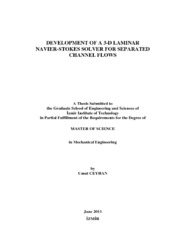Please use this identifier to cite or link to this item:
https://hdl.handle.net/11147/3152Full metadata record
| DC Field | Value | Language |
|---|---|---|
| dc.contributor.advisor | Özkol, Ünver | en |
| dc.contributor.author | Ceyhan, Umut | - |
| dc.date.accessioned | 2014-07-22T13:50:59Z | - |
| dc.date.available | 2014-07-22T13:50:59Z | - |
| dc.date.issued | 2011 | en |
| dc.identifier.uri | http://hdl.handle.net/11147/3152 | - |
| dc.description | Thesis (Master)--Izmir Institute of Technology, Mechanical Engineering, Izmir, 2011 | en |
| dc.description | Includes bibliographical references (leaves: 91-93) | en |
| dc.description | Text in English; Abstract: Turkish and English | en |
| dc.description | xiv, 97 leaves | en |
| dc.description.abstract | This study involves the development of a 3-D laminar Navier-Stokes solver with finite volume method in C++ language and investigation of 3-D separated channel flows. The missing parts of 3-D numerical implementation in Computational Fluid Dynamic books and articles are tried to be revealed within this study. To achieve these, the details of the discretization methods, implementation of boundary conditions and solution algorithm are explained. Besides, a more generalized form of the coefficients of the discretized momentum and pressure correction equations including boundary nodes are proposed. The use of artificial viscosity method achieves converting the conventional channel geometry into different channel geometries. Validation of the code is made investigating developing channel flow, artificial viscosity method and backward facing step flow. There exists an excellent agreement between present study and analytical results and experimental data. The simulation of a 3-D backward facing step is given in detail and the flow structure behind the step geometry is investigated. It was showed that complex three-dimensional flow develops behind the step with reverse and swirling flow regions. The "jet-like" flow and the impingement to the bottom wall are found to be responsible from the minimum on the reattachment line where thestreamwise component of the wall shear stress is zero. The effect of channel expansion ratio on flow structure and pressure recovery is investigated and it is found that as expansion ratio increases, the reattachment line moves toward downstream of channel and the expansion loss coefficient increases. | en |
| dc.language.iso | en | en_US |
| dc.publisher | Izmir Institute of Technology | en |
| dc.rights | info:eu-repo/semantics/openAccess | en_US |
| dc.subject.lcsh | Fluid dynamics | en |
| dc.subject.lcsh | Navier-Stokes equations | en |
| dc.title | Development of a 3-D laminar Navier-Stokes solver for separated channel flows | en_US |
| dc.type | Master Thesis | en_US |
| dc.institutionauthor | Ceyhan, Umut | - |
| dc.department | Thesis (Master)--İzmir Institute of Technology, Mechanical Engineering | en_US |
| dc.relation.publicationcategory | Tez | en_US |
| item.grantfulltext | open | - |
| item.openairetype | Master Thesis | - |
| item.fulltext | With Fulltext | - |
| item.cerifentitytype | Publications | - |
| item.openairecristype | http://purl.org/coar/resource_type/c_18cf | - |
| item.languageiso639-1 | en | - |
| Appears in Collections: | Master Degree / Yüksek Lisans Tezleri | |
Files in This Item:
| File | Description | Size | Format | |
|---|---|---|---|---|
| T000964.pdf | MasterThesis | 1.41 MB | Adobe PDF |  View/Open |
CORE Recommender
Page view(s)
146
checked on Jul 15, 2024
Download(s)
114
checked on Jul 15, 2024
Google ScholarTM
Check
Items in GCRIS Repository are protected by copyright, with all rights reserved, unless otherwise indicated.